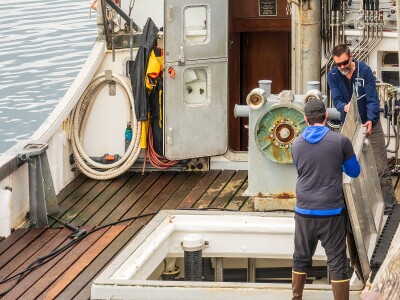Lori French, the daughter-in-law of a crab fisherman, the wife of another, and the mother of a third, placed two large bowls on a table. The one labeled “California” sat empty. The other, reading “Oregon,” was filled to the brim with bright-lavender-and-orange Dungeness crabs. It was early February, the night before the annual hearing of the Joint Committee on Fisheries and Aquaculture at the state capitol, and French, who’s the president of a nonprofit called Central Coast Women for Fisheries, had organized a banquet that was part festive crab feed, part bare-knuckled lobbying effort.
For the benefit of her attendees, who included elected officials, bureaucrats, scientists, and fishermen and their families, she had shipped hundreds of pounds of Dungeness down from Oregon, where, unlike in California, the annual crab season was already under way. She believed that state officials were being too cautious in prohibiting commercial crabbing due to an outbreak of toxic domoic acid, an embargo that had decimated the fortunes of some 1,800 crab-fishing captains and crews in California. Domoic acid, she pointed out, had neither killed nor caused a reported sickening of anyone so far this year. Washington State had let commercial fishermen on the water. Why not reopen the waters in California?
It wouldn’t be that easy. The California Department of Public Health requires scientists to confirm two consecutive clean tests for potentially harmful toxins in locally caught crabs. Since the fall, at least one of every two tests had reported unacceptably high levels of domoic acid, which can poison all kinds of sea life and can sicken and potentially kill humans. By the time I caught up with French again in mid-March, several weeks after the banquet, the state’s crabbers were still out of luck. One recent test had come back clear, French told me over the phone. With one more clean bill of health, her husband and hundreds of other fishermen working the coastline from Santa Barbara up to Crescent City would have been able to drop pots and catch crabs. But when the subsequent test results came back, they weren’t good: A crab had been found with domoic acid levels in its organs at 38 parts per million, 8 above the cutoff level. French was devastated: “Our last bit of hope was just jerked away,” she said.






